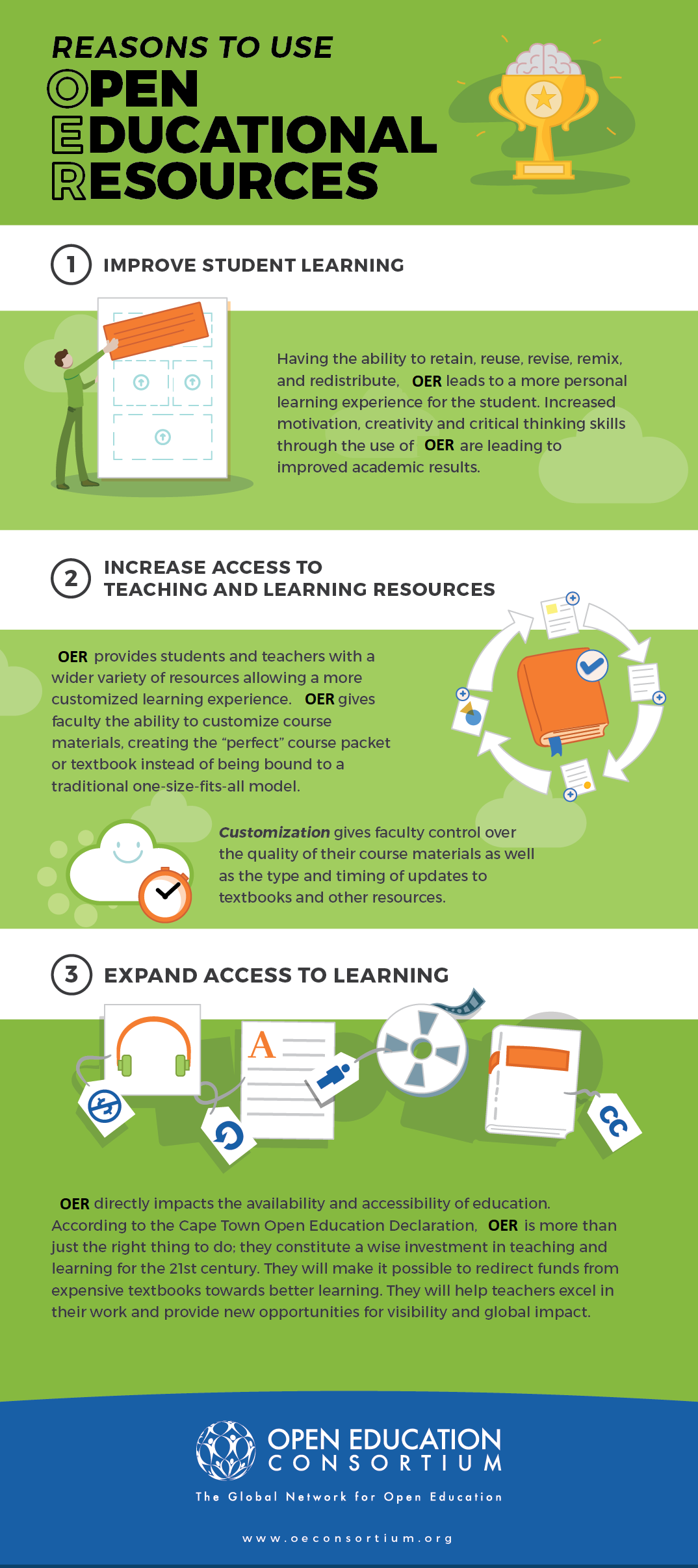1 Introduction to Open Educational Resources
“An Introduction to Open Educational Resources”
By: Abbey Elder. Licensed under CC BY 4.0. Transcript
Learning Objectives
By the end of this chapter, one will be able to:
- Define Open Educational Resources
- Identify Reasons to Use Open Educational Resources
Introduction
Open Educational Resources (OER) provide students and instructors free access to a variety of high quality content. These collective resources have been developed, reviewed, and shared across the world. Instructors can easily adopt OER to use within their courses. Access cost and use of OER are much lower than current rising costs of textbooks and resources.
OPEN = FREE + PERMISSION(S)
Learning Objective Check-In
Defining Open Educational Resources
Scholarly Publishing and Academic Resources Coalition (SPARC) defines OER as
“teaching, learning, and research resources that are free of cost and access barriers, and which also carry legal permission for open use.”
Generally, these permissions are granted by an open license. (Most commercial textbooks do not have open licenses: they are “all rights reserved” with no permissions allowed). Open licenses grant permissions for anyone to use and retain the content under set terms and conditions. Free to access and available in many subjects, OER often extend beyond mere textbooks. OER encompass a wide array of educational materials, including:
- full courses
- course modules
- textbooks
- syllabi
- lectures
- videos
- images
- homework assignments
- quiz questions
- lab activities
- games
- simulations
- and more!
The right to retain allows individuals to keep the content for as long as they wish. “Reuse rights” means anyone can share with others (for example, students). Some OER grant additional permissions, which will be covered later. Most OER are available via the internet. Some OER have print versions for purchase. Most can be printed by individual users.
It is important to note that OER come in a variety of file formats. This screenshot from OER Commons shows the rich selection of file types available for an institution’s listings:

Florida’s Definition of Open Educational Resources
Reasons to Use Open Educational Resources
Instructors benefit from using OER, especially those who want content that meets their individual preferences. Many OER now include ancillary materials and instructor-focused content. Also, instructors can decide when and how to update material: publishers no longer control release of new editions. In addition, OER integrates well with open pedagogy, whereby instructors create a more dynamic, student-centered educational environment, increasing classroom engagement. Instructors who embrace OER are gaining recognition from their institutions and peers; incorporating OER aligns well with the teaching, research, and service criteria for promotion and tenure
The following benefits have been found with OER (Ainsworth, 2020):
- Ability to use, share, edit, and adapt
- Ability to produce the resource in alternate formats
- Ownership of the content forever
- Flexibility in when and whether to move to a new edition
- Access to course content in formats for various devices and situations
- Option to download the text for when internet access is not available
- Instant, unlimited, and permanent access to content
- Eliminate need to buy content multiple times or for longer periods
- Enable use of the content as a reference
- Ease study for entrance and certification exams
- Provide content for lifelong learning and career changes
- Ability to print course material
- Broader student access to course materials
- Increased retention and degree progression (Fischer et al., 2015)
- Lower fail and withdraw rates (Colvard, Watson, and Park, 2018)
- Enhanced pedagogy
- Positive public relations; Increased impact and visibility
- Showcase efforts to reduce student costs
In states across the nation textbook affordability and student success are of utmost importance. OER supports this critical mission. In the infographic below Open Education Global addresses these benefits:

“Reasons to use Open Educational Resources” by Open Education Consortium licensed under CC-BY 4.0 adapted by FLVC and licensed under CC-BY 4.0.
Instructor Voice
“Using OER in my class has been a game-changer. Not only do my students have access to high quality resources, regardless of financial constraints, but I have the flexibility to tailor materials to meet the needs of all my students and align with specific learning objectives. OER is not just about teaching; it’s about enriching the educational landscape and empowering students to succeed.”
Erik Christensen, Physics and Astronomy Professor
South Florida State College
Conclusion
Knowing what OER is and why to use it in the class is the start of the path to adopting OER. The next chapter will dive deeper into defining open content to sharpen an understanding of material available to adopt.

